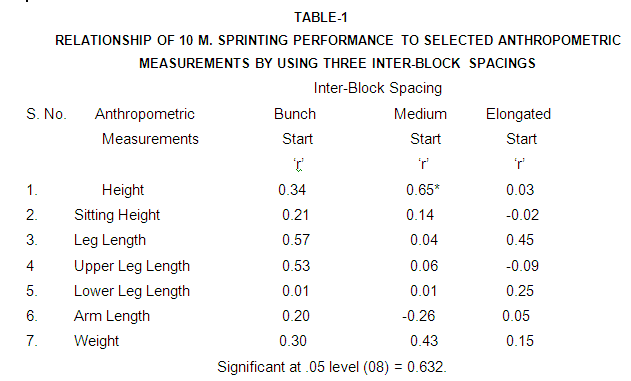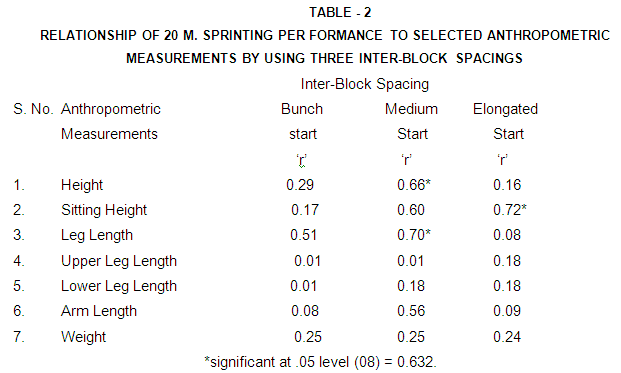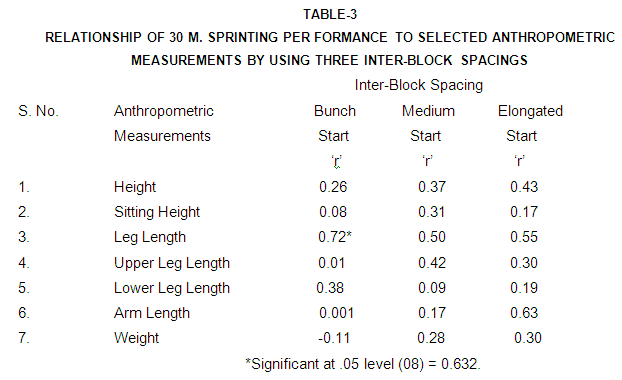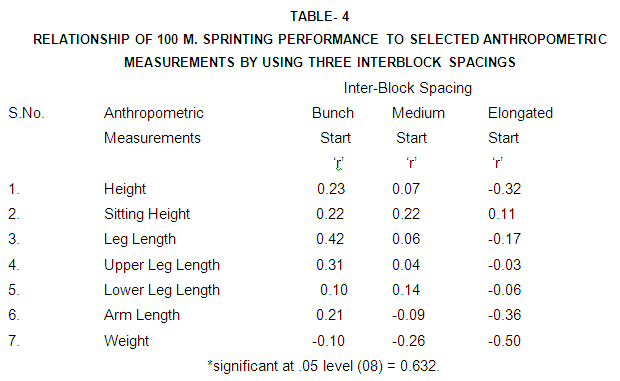Relationship of Selected Anthropometric Measurement to Sprint Performance to University Athletes of Allahabad University
Download PDF
The purpose of this study was to find out the relationship of selected Anthropometric measurement to sprint performance by using different inter-block spacing. Ten male athletes, who have represented intervarsity in sprinting event and studying in the University of Allahabad, were selected as subjects for this study.
"Relationship of Selected Anthropometric Measurement to Sprint Performance to University Athletes of Allahabad University"
Dr. Arvind Mishra
Head
Dept. of Physical Education
Allahabad Degree College, Allahabad
E mail- arvindadc@gmail.com
Cell. No…… 09415014720
Abstract : The purpose of this study was to find out the relationship of selected Anthropometric measurement to sprint performance by using different inter-block spacing. Ten male athletes, who have represented intervarsity in sprinting event and studying in the University of Allahabad, were selected as subjects for this study. Their age varied between 18 - 25 years. Only three starting position with inter-block spacing i.e. bunch start, medium start and elongated start were used for this study. Selected anthropometric measurement were height, sitting height, leg length, lower leg length, upper leg length, arm length and weight and different inter block spacing were bunch start, medium start and elongated start. The subjects run 100 m. and were timed at different check points that are 10 m., 20 m., 30 m. and 100 m. marks. In order to find out the reliability of data test-retest method was used. Coefficients of correlation were calculated by using Pearson's product moment correlation. As a result it is found that Different inter-block spacing had an effect on the performance of male sprinters at 100 m. mark and different inter-block spacing had some effect in different anthropometric variables at different check points.
KEY WORDS : Anthropometric measurement, Inter Block Spacing, Bunch Start, Medium Start, Elongated Start etc.
INTRODUCTION: Track and Field got its popularity because of its similarity with daily life doings. It is a known fact that soon after a human infant move to crawl to walk, he takes interest in throwing etc., which appeals him to follows therefore, that since the events on the track field programme are fundamental movements they soon find their place in the lives of the young aspirant youth.
Speed items commonly known as sprinting events have been on the agenda of the modern Olympic Games from the very beginning. Speed plays a vital role in all games and sports but it plays a very dominant role specialty for the sprinters. For a sprinter to give good performance, he must possess acceleration speed, sprinting speed, speed of movement and reaction time.
Sprinting is one of the popular events in track and field 100m, 200m, 400m etc are some of the events which demands supreme efforts, excellent physical fitness, sufficient strength and speed. These events have a different form of start from the other events such as 800m m and above which has standing starts. The sprinters of these events use blocks to start because of its mechanical advantages. Proper starting is one of the most important fundamentals of good sprinting. And often races are decided by inches made or lost on at the start. We can say that a start is the fuel that ignites the rocket propulsion of the sprinter to supreme speed with the sole purpose to reach maximum speed in minimum time.
Crouch start originated with Sherrill of Yale in 1988, and has been used universally since then. In starting it was made from holes dug in track but now it is accomplished by the assistance of starting blocks. Various research and experiments have shown that the crouch start position gives mechanical advantages and on the top of usage of blocks gives added push to the sprinter which is essential in short races.
The various starts which a sprinter normally takes are medium start, bunch start and elongated start. The form of individual sprinters may vary in details, but the basic fundamentals are the same.
The stronger foot is placed on the front block. The athletes' problem at start may be as where to place his feet so as to promote the maximum amount of work off his front foot combined with steadiness and control over the initial strides. This in effect will mean he must bring his foot as forward as possible without upsetting his initial strides. Furthermore the nearer he comes to the line the more weight he will have over and in front of the line and though his drive, off the front foot will built up more slowly and from a point nearer to the finish than an athlete who places his front foot further back. Not only the front block but also the back foot until you fined the power points on the blocks. These are the points where the sprinter feels he has maximum power to drive with both of his legs in shortest possible time.
In order to have a quick start the sprinter and their coaches had been experimenting different types of start the crouch start is probably one of the sports technique on which so many studies have been carried out but still answer too many questions awaited. For example inter block spacing with relation to the physical structure is still a difficult question to answer keeping in their view the researcher want to find out a logical solution for such a ticklish task.
Definitions of Operational Terms
Anthropometric measurement : Anthropometric measurement refer to those measurement of human body such as height, weight and measurement of certain body parts e.g. arm length, leg length and shoulder width etc.
Inter Block Spacing: Distance between the front edge of front and rear blocks known as inter block spacing.
Crouch Start: The three accepted positions are known as the bunch start, the medium start and the elongated start. A perfect start is one which gives (a) the quickest response to the gun, and (b) the maximum forward velocity and continuing acceleration subsequently and is achieved by the application of force from both legs assisted initially by the use of starting block.
Bunch Start: Where the feet are closer together, about one foot length apart.
Medium Start: Where the feet are further apart, about the length of the lower leg i.e. the knee of the rear leg is placed level at the toe of the front foot.
Elongated Start: Where the feet are even further apart, generally given slower movements but gives together strides which may be necessary particularly for hurdler enabling them to get to the correct take off position for the first hurdle.
The following anthropometric measurements were taken on each subject by using standard techniques:
Stature, sitting height, leg length, upper leg length, lower leg length, arm length and body weight The selection of the above mentioned anthropometric variables is based on the facts that these were mainly referred in literature and they may relate to the performance of sprinters.
Criterion Measures : The criterion measures chosen for testing hypothesis were
1. The time taken by subject in order to mn the distance of 10 m., 20 m.,30 m and 100 meters.
Administration of Tests:
Anthropometric Variables: For the purpose of the study only seven anthropometric measurements were taken.
Height: The height of the subject was taken with the help of stadiometer. The subject was asked to stand erect on the platform of the stadiometer, bare footed with heels, buttocks and back of the head touching the vertical stand of the stadiometer. The jaw of the stadiometer was placed parallel to the apex of head, and the measurement was recorded to the nearest half cm.
Sitting Height: The subject sat erect on a table with his feet unsupported. The right angle formed at the knee almost but not completely touched the edge of the table. The hands rested on the thighs. The head was oriented in the Frankfort plane (the upper border of the ear opening and the lower border of the eye socket on a horizontal line), and the distance between the vertex and the table was measured and recorded as the sitting height.
Leg Length: Leg length was measured with a flexible steel tape, from the greater trochanter head of the femur to the outside edge of the center of the foot.
Lower Leg Length: The fore leg length was measured vertically from the most protuberant part of the patella to the upper edge of the greater trochanter.
Upper leg Length: Thigh length was measured vertically from the most protuberant part of the patella to the upper edge of the greater trochanter.
Arm Length: Arm length was taken from acromion process to the tip of the third finger.
All the measurements were recorded to the nearest half cm.
Weight: Weight of each subject was recorded by using a weighing machine. The subject wore a swimming costume was asked to stand on the weighing machine and the weight was recorded to the nearest half kilogram.
Sprint Performance: Subjects were allowed to have sufficient warming up on their own so that they could give good performance. Proper commands of sprints were used to give for the start, to the subjects. The distance of 10 m, 20 m, 30 m and 100 m were marked. The timings of each subject were taken by two time keepers using digital manual times to the nearest 1/100th of a second.
Analysis of Data
In order to find out the relationship between the selected anthropometric measurements to sprint performance using different inter block spacing, Karle Pearson's product moment correlation was used. To test the hypothesis the level of significance was 0.05 level. The results were presented in a tabular form.
Findings
In order to ascertain the relationship of selected anthropometric measurements i.e. height. sitting height, leg length, upper leg length, lower leg length, arm length and weight with the performance of subjects at 10 m mark, 20 m mark 30 m mark and 100 m mark while using different inter block spacing i.e. bunch, medium and elongated are given in Table 1, 2, 3 and 4

As revealed by Table-1 that only in case of height at 10 m mark when the subjects have used medium start the value of coefficient of correlation (0.65) was found to be significant at .05 level of confidence. In case of all other variables the values of coefficient of correlation have shown insignificant relationship in different type of inter-block spacing.

As revealed in table-2 that there is a significant relationship between medium start and height (0.66), elongated start and sitting height (-0.72), medium start and leg length (0.70) in the performance of 20 m mark. In case of other variables the values of coefficient of correlation have shown insignificant relationship in different types of inter types of inter block spacing.

As revealed by Table-3 that only in case of leg length at 30 m. mark when the subject have used bunch start the value of coefficient of correlation (072) was found significant at the selected 0.05 level of confidence. In case of all other variables the values of coefficient at correlation have shown insignificant relationship in different type of inter block spacing.

As revealed in Table-4, in case of all variables the values of coefficient at correlation have shown insignificant relationship between 100 m. performance and different type of inter-block spacing at the selected 0.05 level of confidence.
Findings
The results of table-1 have exhibited the significant relationship between the heights of the subject with their performance of 10 meter when the subject used medium start. The obtained significant values of coefficient have shown the positive relationship between the height and the performance. As exhibited in table-2 that the heights of the subjects have shown the significant relationship with the performance of the subjects at 20 meter mark in case the subjects used medium start, the result had similar trends as discussed earlier.
The result of table-3 has shown the significant relationship between the leg length of the subjects and their performance in 30 meters when the subject used bunch start. The results had similar trends as discussed earlier
The result of table-4 has shown that no significant relationship has occurred between the Anthropometric Measurements i.e. (Height, Sitting height, Leg length, Upper leg length, Lower leg length, Arm length and Weight) and their performance in 100 meter Dash when the subjects used Bunch, Medium and Elongated start. This may be due to the fact that the students could not able to carry out the performance in 100 meter dash.
On the basis of Findings of the study following conclusions were drawn:
- Different inter block spacing had an effect on the performance of male sprinters at 100 m. mark.
- Different inter block spacing had some effect in different anthropometric variables at different check points.
BIBLIOGRAPHY
- Conger, Ray M., Track and Field (New York A. S Barnes and Co. 1939).
- Cureton, Thomas Kirk Physical Fitness of Champion Athletes (Urbana: The University of Illinois Press, 1961).
- Ecker, Tom Championship Track and Field (Englewood Cliffs, NJ. Prentice Hall Inc. 1957).
- Johnson, Barry L and Nelson, Jack K Practical Measurements for Evaluation in Physical Education (Delhi Surjeet Publications 1982).
- Jordon, Payton and Spencher, Bud, Champions in the Making (Englewood N J Prentice Hall inc 1968)
- Luke. G Coaching High School Track and Field (London Nicholas Kaya Limited 1956.
- Mathews, Donald K. Measurement in Physical Education (Philadelphia W. B. Saunders Co. 1976).
- Pearson, G. F. D. Athletics (Edinburgh Thomas Nelson and Sons Ltd. 1963).
- Sodhi, H S and Sidhu, L.S. Physique and Selection of Sportsman (Patiala Punjab Publishing House. 1934).
- Stem, Julion V 'Championship Sprinting Scholastic Coach 32-6 (February 1963).
- Beck, Charles W "Block Spacing and Selected Measurement in the Sprint Start," Completed Research in Health, Physical Education and Recreation 11 (196).
- Blancani, Albert W. 'The Effect of Foot Width Placement o.n Sprint Starting" Dissertation Abstracts International 33 9 (March 1973).
- Bosen, Ken O., et al. "Comparative Study of Starting with and Without Blocks to Determine Stride Length and Stride Frequency in the Acceleration Phase". NSNIS Scientific Journal 10:4 (October 1987):
- Dickinson. A.D. Effect of Foot Spacing on the Starting Time and Speed in Sprinting and Relation of Physical Measurement of Foot Spacing' Research Quarterly 5 (1934)
- Henry, Franklin M "Force-time Factor of the Sprint Start, Research Quarterly 23 3 (October 1952).
- Keith, Gooden "The Relationship of Selected Anthropometric Measurements of the Leg and Foot to the Speed and Vertical Jump at Male Collegiate Track and Field Athletes," Completed
- Morris, Harold Homes "The Effect of Starting Block, Length Angle and Position upon Sprint Performance". Dissertation Abstracts International 33: 1 (July 1972)
- Spirduco, Craig Dcnvico, Relationship between Strength arid Speed as Affected by Limb Length, Completed Research in Health, Physical Education and Recreation 15 (1973).
- Stock, Malcolm. 'Influence of Various Track Starting Positions of Speed,' Research Quarterly 33:4 (1962').

















